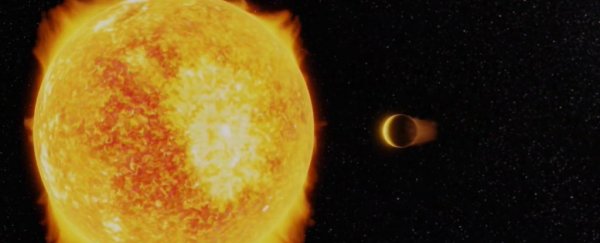A new exoplanet discovery is the first of its kind, sitting in a strange 'gap' of exoplanets insanely close to their host stars. The planet is a Neptune-sized body that whips around its star once every 19 hours.
Never before has a Neptune-sized exoplanet been found with an orbital period of less than a day.
Usually, exoplanets this close to their star are either gas giants, known as ultra-hot Jupiters, or smaller, rocky planets like Earth, Mercury, Mars and Venus, known as ultra-short period planets. This new class, represented by this sole member, has been dubbed "ultra-hot Neptunes".
Curiously, its properties suggest the exoplanet has a similar density to Neptune, with an atmosphere that constitutes at least 9 percent of the planetary mass. This raises the question, how has that atmosphere not evaporated in the scorching heat of its star?
"The planet exists in something known as the 'Neptune Desert', a region devoid of planets when we look at the population of planetary masses and sizes," said astronomer James Jenkins of the University of Chile.
"Although icy giants seem to be a fairly common by-product of the planet formation process, this is not the case very close to their stars. We believe these planets get stripped of their atmospheres over cosmic time, ending up as so-called ultra-short period planets."
The planet, called LTT 9779b, orbits a star 260 light-years away called LTT 9779. This star is a lot like our Sun, with roughly the same size and mass, and only slightly cooler. However, it's younger - 2 billion years to the Sun's 4.6 billion - and accordingly has a higher metal content, with twice the iron of the Sun.
Around this star, the orbit of LTT 9779b is tiny, just 2.5 million kilometres at the semi-major axis. That's around 1.6 percent of the distance between Earth and the Sun. At that close proximity, the exoplanet would be heated to temperatures in excess of 1,970 Kelvin (around 1,700 degrees Celsius, or 3,100 Fahrenheit).
Exoplanets are measured using two main techniques. The transit data - how much the star's light dims when the exoplanet passes in front of it - can be used to calculate its size. The radial velocity data - how much the star wobbles as it is slightly tugged by the exoplanet's gravity - can be used to calculate the mass.
Armed with these data, the researchers calculated that LTT 9779b is around 29.32 times the mass of Earth, and 4.72 times its size. Neptune, for comparison, is 17.1 times the mass of Earth, and 3.88 times its size.
Since density can be used to infer composition, the characteristics of LTT 9779b suggest it has a similar composition to Neptune - a large rocky core, and a substantial atmosphere. And therein, scientists say, lies the rub. That atmosphere should have been scorched away through a process called photoevaporation.
"Intense X-ray and ultraviolet from the young parent star will have heated the upper atmosphere of the planet and should have driven the atmospheric gases into space," said astronomer George King of the University of Warwick in the UK.
"Photoevaporation should have resulted in either a bare rock or a gas giant. Which means there has to be something new and unusual we have to try to explain about this planet's history."
The metallicity of the star could be a clue - such stars are more likely to host gas giant exoplanets than their more metal-poor relatives. LTT 9779b could be a rarely seen intermediary step between gas giants and short-period rocky planets.
"Planetary structure models tell us that the planet is a giant core dominated world, but crucially, there should exist two to three Earth-masses of atmospheric gas. But if the star is so old, why does any atmosphere exist at all?" Jenkins said.
"Well, if LTT 9779b started life as a gas giant, then a process called Roche Lobe Overflow could have transferred significant amounts of the atmospheric gas onto the star."
The discovery of a large rocky planet, thought to be the stripped-down core of what was once a gas giant, was announced earlier this year, on an 18-hour orbit around its star. So, it stands to reason that we might come across the intermediary step in the process sooner or later.
It's also possible that LTT 9779b started its life much farther from its star and migrated inwards, its orbit disrupted through gravitational interactions with other planets. If that's the case, it could have retained its atmosphere much longer than if it had formed in its current position.
What we do know is that the exoplanet seems to have a significant atmosphere, and passes in front of its star every 19 hours. That makes it an excellent candidate for follow-up study, where light from the star that passes through the atmosphere can be analysed to ascertain the atmospheric composition.
"The planet is very hot, which motivates a search for elements heavier than hydrogen and helium, along with ionised atomic nuclei," Jenkins said.
"It's sobering to think that this 'improbable planet' is likely so rare that we won't find another laboratory quite like it to study the nature of ultra-hot Neptunes in detail. Therefore, we must extract every ounce of knowledge that we can from this diamond in the rough, observing it with both space-based and ground-based instruments over the coming years."
The research has been published in Nature Astronomy.
